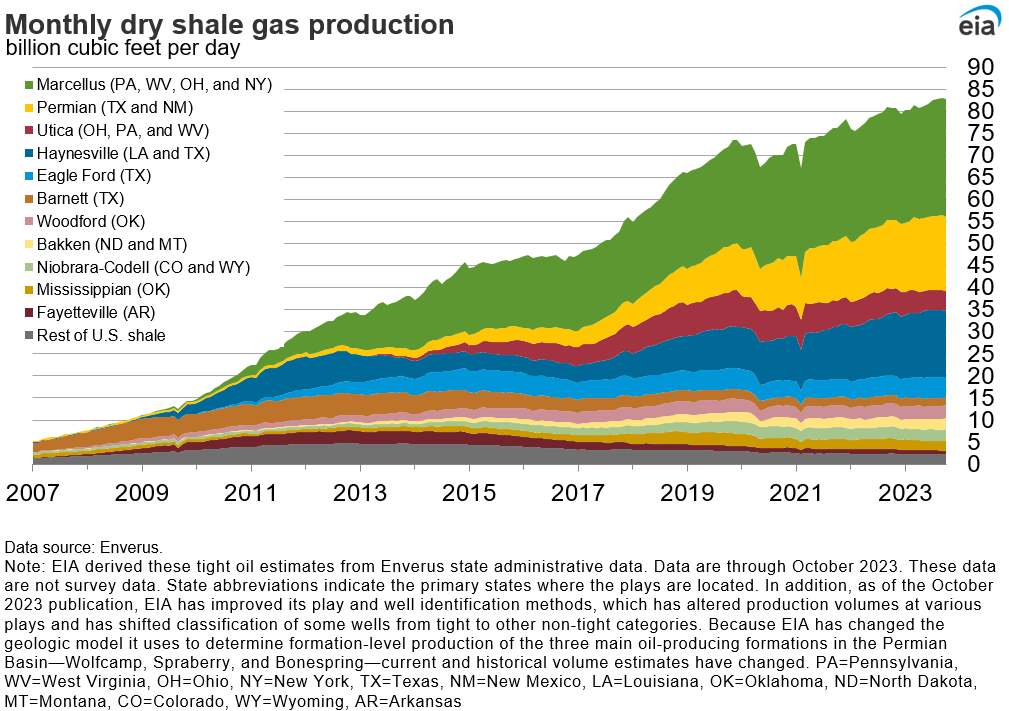In the News:
Japan and South Korea LNG storage has been at peak monthly levels for most of 2023
From August 2022 through July 2023, the monthly volumes of liquefied natural gas (LNG) stored at Japan’s above-ground storage tanks reached all-time highs, according to data from Japan’s Ministry of Economy, Trade, and Industry. Similarly, South Korea’s LNG inventory in above-ground storage tanks has reached record levels from October 2022 through August 2023 (the most recent month for which data are available), according to South Korea’s Energy Economics Institute.
For more than 20 years, Japan and South Korea have been two of the top three importers of LNG globally. Neither Japan nor South Korea have international pipeline interconnections, and both import all natural gas in the form of LNG. Since neither country has underground storage facilities, natural gas is stored as LNG in above-ground storage tanks co-located with LNG import terminals (called regasification terminals).
Japan has the world’s largest LNG storage capacity in above-ground storage tanks located at more than 30 regasification facilities, totaling 20.1 million liquid cubic meters (MMcm) or the equivalent of 425.1 billion cubic feet (Bcf) of gaseous natural gas in 2022, according to data from the International Group of Liquefied Natural Gas Importers (GIIGNL). South Korea has the world’s second-largest LNG storage capacity—14.1 liquid MMcm (298 Bcf of gaseous natural gas)—located in above-ground storage tanks at seven regasification terminals.
The 2022‒23 winter weather was very mild in East Asia, which contributed to lower-than-average LNG imports and consumption during winter months and further accumulation of LNG in storage tanks in both Japan and South Korea. From January through July 2023, monthly onsite LNG storage in Japan reached the highest level on record for each month, before declining in August and September because of higher consumption from the natural gas-fired electric generation sector. Similarly in South Korea, from January through August 2023, monthly onsite LNG storage volume totaled the highest on record for each month.
LNG inventories at regasification facilities in Japan and South Korea help meet seasonal swings in natural gas demand, particularly in winter months when demand for space heating is highest. In Japan, from January 2010 through August 2023, the volume of LNG in storage tanks varied between 29% and 69% of available LNG storage capacity. Over the same period in South Korea, the volume of LNG in storage tanks varied between 17% and 90%.
The volume of LNG in above-ground storage tanks is considered an emergency stockpile that can be used if LNG imports from all global sources are halted. In Japan, the LNG stockpile can provide an average of about 19 days based on 2011–2023 monthly LNG inventory and natural gas consumption. In South Korea, the LNG stockpile can provide an average of 30 days of LNG supplies. Lack of underground natural gas storage capacity and international pipeline interconnections highlights Japan’s and South Korea’s dependence on real-time LNG shipments.
Market Highlights:
(For the week ending Wednesday, December 6, 2023)Prices
- Henry Hub spot price: The Henry Hub spot price rose 3 cents from $2.70 per million British thermal units (MMBtu) last Wednesday to $2.73/MMBtu yesterday.
- Henry Hub futures price: The price of the January 2024 NYMEX contract decreased 23.5 cents, from $2.804/MMBtu last Wednesday to $2.569/MMBtu yesterday. The price of the 12-month strip averaging January 2024 through December 2024 futures contracts declined 23.8 cents to $2.746/MMBtu.
- Select regional spot prices: Natural gas spot prices fell at most locations this report week (Wednesday, November 29 to Wednesday, December 6). Price changes ranged from a decrease of $2.34/MMBtu at the Opal hub to an increase of $6.30/MMBtu at the Algonquin Citygate.
- Prices at most major hubs in the Northeast rose this report week. At the Algonquin Citygate, which serves Boston-area consumers, the price rose $6.30 from $3.50/MMBtu last Wednesday to $9.80/MMBtu yesterday. Temperatures in the Boston Area averaged 41°F this report week, resulting in 13 fewer heating degree days (HDDs) than normal for the week, but temperatures dropped below normal on Tuesday and Wednesday which increased demand for natural gas for space heating at the end of the report week. Spot prices at the Algonquin Citygate hub rose to an intraweek high of $13.13/MMBtu on Tuesday with lower temperatures toward the end of the report week. In response to rapidly rising demand the Algonquin Gas Transmission pipeline issued an operational flow order on Tuesday, calling on shippers to ensure “that actual deliveries of gas out of the system must be equal to or less than scheduled deliveries.” In addition, since October 20, the Millstone nuclear power station in Waterford, Connecticut, has been operating at approximately 40% of capacity, which is contributing to increased natural gas consumption for electric power generation to make up for lower nuclear power-generation capacity.
- In the Midwest, the Chicago Citygate price decreased 18 cents from $2.55/MMBtu last Wednesday to $2.37/MMBtu yesterday following a 15% (3.0 Bcf/d) decrease in natural gas consumption. Residential and commercial sector consumption fell 22% (2.5 Bcf/d) week over week. Temperatures in the Chicago Area averaged 39°F this week, 5°F above normal, which resulted in 182 HDDs, 67 HDDs fewer than last week and 34 HDDs fewer than normal. In response to lower consumption, net natural gas flows into the Mid-Continent region, which come from Canada, the Rocky Mountain region, and the Northeast region, fell 10% (0.9 Bcf/d), according to data from S&P Global Commodity Insights.
- Prices across the West decreased this week. The price at PG&E Citygate in Northern California fell $1.30, down from $6.16/MMBtu last Wednesday to $4.86/MMBtu yesterday, and the price at the SoCal Citygate in Southern California decreased $1.82 from $6.19/MMBtu last Wednesday to $4.37/MMBtu yesterday. Temperatures in the Sacramento Area averaged 53°F this week, resulting in 85 HDDs, 20 HDDs fewer than last week and 28 HDDs fewer than normal. The price at the Opal hub in Southwest Wyoming, which delivers natural gas to PG&E at Malin via the Ruby Pipeline, fell $2.34 from $5.89/MMBtu last Wednesday to $3.55/MMBtu yesterday. The price at Northwest Sumas on the Canada-Washington border and the main natural gas pricing point in the Pacific Northwest fell $2.29 from $5.87/MMBtu last Wednesday to $3.58/MMBtu yesterday. Natural gas consumption in the Pacific Northwest fell 18% (0.6 Bcf/d), led by a 33% (0.5 Bcf/d) decrease in residential and commercial sector consumption. Temperatures in the Seattle City Area averaged 47°F, resulting in 127 HDDs, 44 HDDs fewer than last week, and 27 HDDs fewer than normal.
- Natural gas spot prices at the Waha hub in West Texas, which is located near Permian Basin production activities, fell $1.32 this report week, from $1.96/MMBtu last Wednesday to $0.64/MMBtu yesterday. The Waha Hub traded $2.09 below the Henry Hub price yesterday, compared with last Wednesday when it traded 74 cents below the Henry Hub price. Yesterday, El Paso Natural Gas Company (EPNG) issued a notice of a high linepack condition due to lower natural gas deliveries and higher supply receipts. EPNG also reported maintenance on its system, including Line 2000, which ships natural gas west out of the Permian Basin, and it was operating at reduced capacity this report week.
- International futures prices: International natural gas futures prices decreased this report week. According to Bloomberg Finance, L.P., weekly average front-month futures prices for liquefied natural gas (LNG) cargoes in East Asia decreased 47 cents to a weekly average of $16.10/MMBtu. Natural gas futures for delivery at the Title Transfer Facility (TTF) in the Netherlands decreased $1.06 to a weekly average of $12.91/MMBtu. In the same week last year (week ending December 7, 2022), the prices were $32.98/MMBtu in East Asia and $42.95/MMBtu at TTF.
- Natural gas plant liquids (NGPL) prices: The natural gas plant liquids composite price at Mont Belvieu, Texas, rose by 19 cents/MMBtu, averaging $6.92/MMBtu for the week ending December 6. Weekly average ethane prices fell 4%, while weekly average natural gas prices at the Houston Ship Channel fell 7%. The ethane premium to natural gas rose 10% week over week. The ethylene spot price rose 1%, increasing the ethylene premium to ethane by 3%. The average weekly propane price rose 9%, while the Brent crude oil price fell 4%. The propane discount relative to crude oil decreased 17% on the week. Normal butane prices rose 12%, isobutane prices fell 4%, and natural gasoline prices fell 1%.
Daily spot prices by region are available on the EIA website.
Supply and Demand
- Supply: According to data from S&P Global Commodity Insights, the average total supply of natural gas fell by 0.5% (0.6 Bcf/d) compared with the previous report week. Dry natural gas production decreased by 0.2% (0.2 Bcf/d) to a weekly average of 105.0 Bcf/d, and average net imports from Canada decreased by 5.9% (0.4 Bcf/d) from last week.
- Demand: Total U.S. consumption of natural gas fell by 9.4% (9.3 Bcf/d) compared with the previous report week, according to data from S&P Global Commodity Insights, as warmer temperatures across most of the Lower 48 states reduced demand for space heating. Natural gas consumed for power generation declined by 2.4% (0.8 Bcf/d) week over week, and industrial sector consumption decreased by 2.8% (0.7 Bcf/d). Residential and commercial sector consumption declined by 19.2% (7.8 Bcf/d). Natural gas exports to Mexico increased 5.6% (0.3 Bcf/d). Natural gas deliveries to U.S. LNG export facilities (LNG pipeline receipts) averaged 14.1 Bcf/d, or 0.2 Bcf/d lower than last week.
Liquefied Natural Gas (LNG)
- Pipeline receipts: Average natural gas deliveries to U.S. LNG export terminals decreased by 1.6% (0.2 Bcf/d) week over week, averaging 14.1 Bcf/d, according to data from S&P Global Commodity Insights. Natural gas deliveries to terminals in South Louisiana decreased by 1.3% (0.1 Bcf/d) to 8.6 Bcf/d. Natural gas deliveries to terminals in South Texas decreased by 4.2% (0.2 Bcf/d), and natural gas deliveries to terminals outside the Gulf Coast increased by 6.8% (0.1 Bcf/d).
- Vessels departing U.S. ports: Twenty-nine LNG vessels (eight from Sabine Pass; five each from Cameron, Corpus Christi, and Freeport; and two each from Calcasieu Pass, Cove Point, and Elba Island) with a combined LNG-carrying capacity of 105 Bcf departed the United States between November 30 and December 6, according to shipping data provided by Bloomberg Finance, L.P.
Rig Count
- According to Baker Hughes, for the week ending Tuesday, November 28, the natural gas rig count decreased by 1 rig to 116 rigs. The Marcellus added one rig and two rigs were dropped among unidentified producing regions. The number of oil-directed rigs rose by 5 rigs to 505 rigs. The Permian and Cana Woodford added three rigs each, and one rig was dropped among unidentified producing regions. The total rig count, which includes 4 miscellaneous rigs, increased by 3 and now stands at 625 rigs, 159 rigs fewer than last year at this time.
Storage
- Net withdrawals from storage totaled 117 Bcf for the week ending December 1, compared with the five-year (2018–2022) average net withdrawals of 48 Bcf and last year's net withdrawals of 30 Bcf during the same week. Working natural gas stocks totaled 3,719 Bcf, which is 234 Bcf (7%) more than the five-year average and 254 Bcf (7%) more than last year at this time.
- According to The Desk survey of natural gas analysts, estimates of the weekly net change to working natural gas stocks ranged from net withdrawals of 96 Bcf to 127 Bcf, with a median estimate of 106 Bcf.
See also:
Top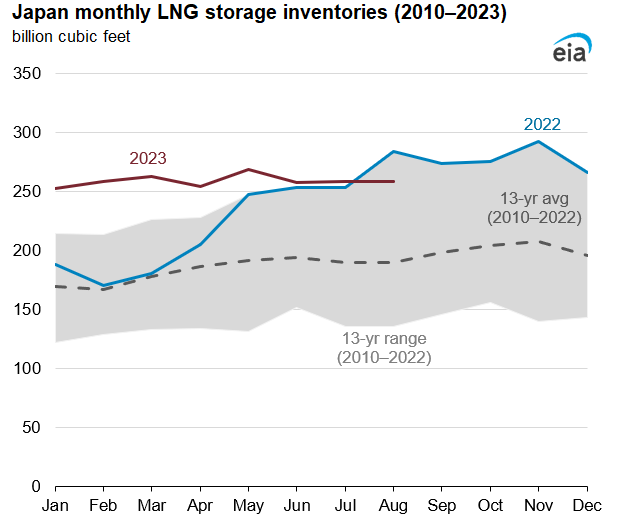 Data source: Japan Ministry of Economy, Trade, and Industry, Japan Agency for Natural Resources and Energy
Data source: Japan Ministry of Economy, Trade, and Industry, Japan Agency for Natural Resources and Energy Note: LNG=liquefied natural gas
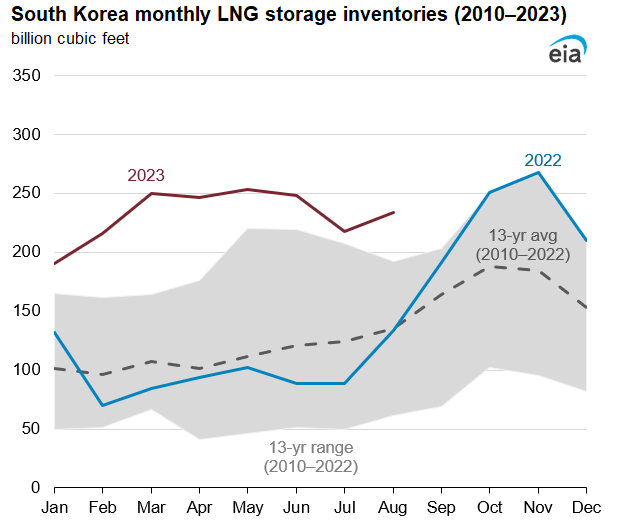 Data source: South Korea Energy Economics Institute
Data source: South Korea Energy Economics Institute Note: LNG=liquefied natural gas
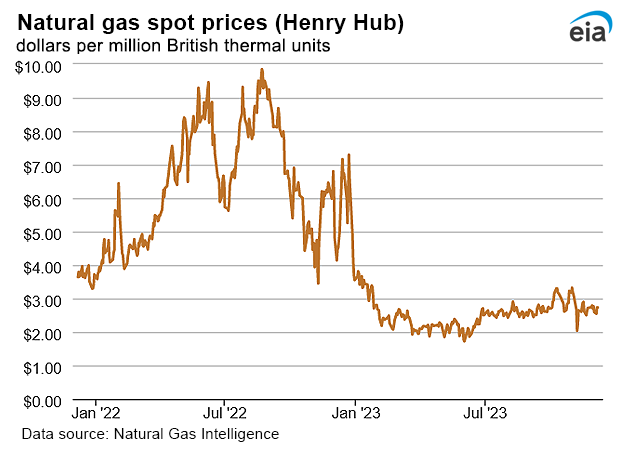
| Spot Prices ($/MMBtu) | Thu, 30-Nov |
Fri, 01-Dec |
Mon, 04-Dec |
Tue, 05-Dec |
Wed, 06-Dec |
|---|---|---|---|---|---|
| Henry Hub |
2.77 |
2.60 |
2.55 |
2.73 |
2.73 |
| New York |
2.22 |
2.01 |
2.37 |
3.70 |
2.74 |
| Chicago |
2.47 |
2.35 |
2.42 |
2.51 |
2.37 |
| Cal. Comp. Avg.* |
5.12 |
4.69 |
4.38 |
4.50 |
4.24 |
| Futures ($/MMBtu) | |||||
| January contract | 2.802 |
2.814 |
2.694 |
2.710 |
2.569 |
| February contract |
2.763 |
2.773 |
2.651 |
2.667 |
2.517 |
| *Avg. of NGI's reported prices for: Malin, PG&E Citygate, and Southern California Border Avg. | |||||
| Data source: NGI's Daily Gas Price Index | |||||
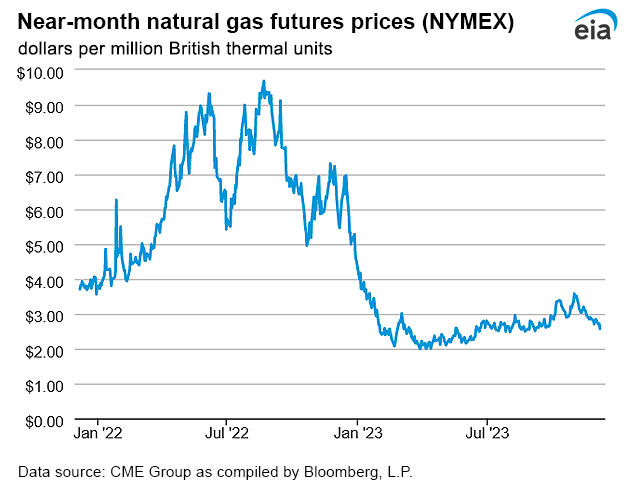
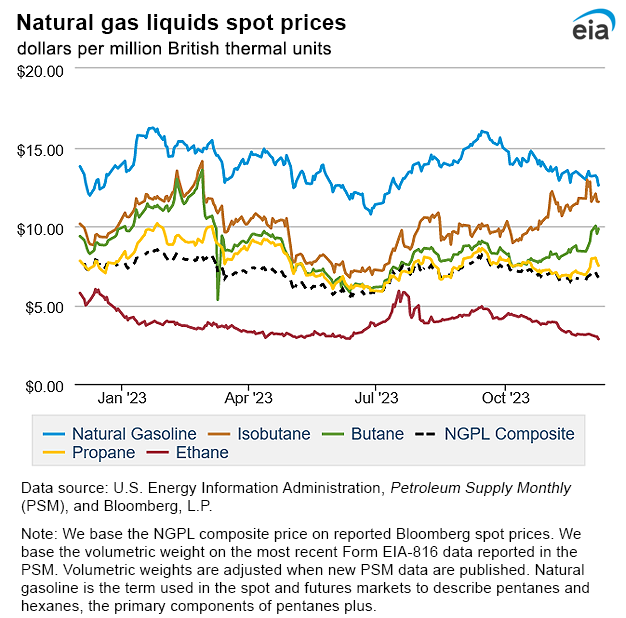
| U.S. natural gas supply - Gas Week: (11/30/23 - 12/6/23) | |||
|---|---|---|---|
Average daily values (billion cubic feet) |
|||
this week |
last week |
last year |
|
| Marketed production | 119.1 |
119.4 |
115.1 |
| Dry production | 105.0 |
105.2 |
102.0 |
| Net Canada imports | 5.6 |
5.9 |
5.3 |
| LNG pipeline deliveries | 0.1 |
0.1 |
0.1 |
| Total supply | 110.7 |
111.3 |
107.4 |
|
Data source: S&P Global Commodity Insights | |||
| U.S. natural gas consumption - Gas Week: (11/30/23 - 12/6/23) | |||
|---|---|---|---|
Average daily values (billion cubic feet) |
|||
this week |
last week |
last year |
|
| U.S. consumption | 89.8 |
99.1 |
90.1 |
| Power | 32.3 |
33.1 |
29.7 |
| Industrial | 24.5 |
25.2 |
24.0 |
| Residential/commercial | 33.0 |
40.8 |
36.3 |
| Mexico exports | 6.5 |
6.1 |
5.4 |
| Pipeline fuel use/losses | 7.7 |
7.9 |
7.5 |
| LNG pipeline receipts | 14.1 |
14.3 |
11.9 |
| Total demand | 118.1 |
127.5 |
114.9 |
|
Data source: S&P Global Commodity Insights | |||
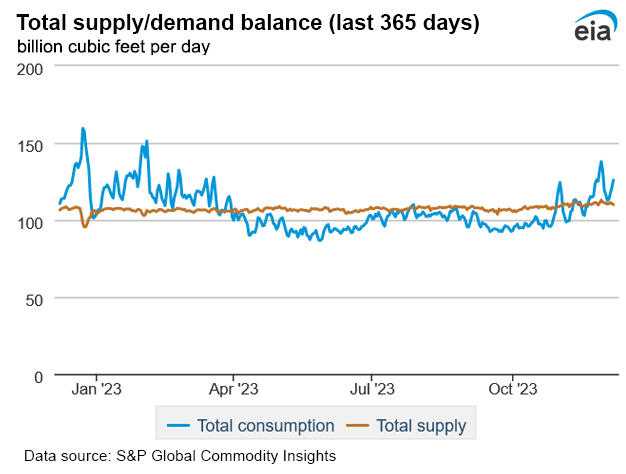
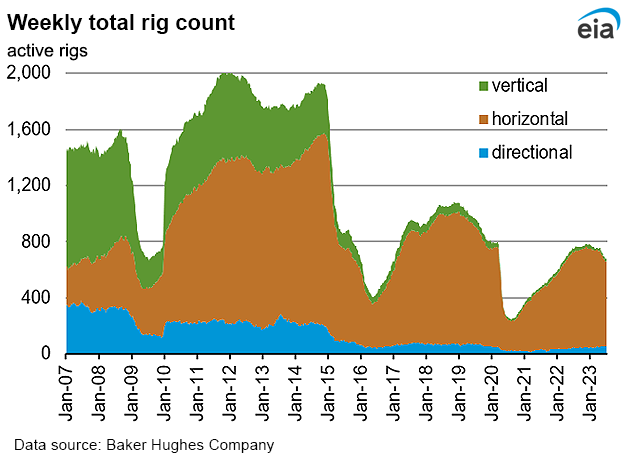
| Rigs | |||
|---|---|---|---|
Tue, November 28, 2023 |
Change from |
||
|
last week
|
last year
|
||
| Oil rigs |
505
|
1.0%
|
-19.5%
|
| Natural gas rigs |
116
|
-0.9%
|
-25.2%
|
| Note: Excludes any miscellaneous rigs | |||
| Rig numbers by type | |||
|---|---|---|---|
Tue, November 28, 2023 |
Change from |
||
|
last week
|
last year
|
||
| Vertical |
12
|
-7.7%
|
-52.0%
|
| Horizontal |
559
|
0.9%
|
-21.4%
|
| Directional |
54
|
-1.8%
|
12.5%
|
| Data source: Baker Hughes Company | |||
| Working gas in underground storage | ||||
|---|---|---|---|---|
Stocks billion cubic feet (Bcf) |
||||
| Region | 2023-12-01 |
2023-11-24 |
change |
|
| East | 876 |
915 |
-39 |
|
| Midwest | 1,082 |
1,111 |
-29 |
|
| Mountain | 245 |
252 |
-7 |
|
| Pacific | 289 |
298 |
-9 |
|
| South Central | 1,228 |
1,260 |
-32 |
|
| Total | 3,719 |
3,836 |
-117 |
|
|
Data source: U.S. Energy Information Administration Form EIA-912, Weekly Underground Natural Gas Storage Report
Note: Totals may not equal sum of components because of independent rounding. | ||||
| Working gas in underground storage | |||||
|---|---|---|---|---|---|
Historical comparisons |
|||||
Year ago (12/1/22) |
5-year average (2018-2022) |
||||
| Region | Stocks (Bcf) |
% change |
Stocks (Bcf) |
% change |
|
| East | 835 |
4.9 |
848 |
3.3 |
|
| Midwest | 1,030 |
5.0 |
1,021 |
6.0 |
|
| Mountain | 194 |
26.3 |
200 |
22.5 |
|
| Pacific | 218 |
32.6 |
266 |
8.6 |
|
| South Central | 1,190 |
3.2 |
1,150 |
6.8 |
|
| Total | 3,465 |
7.3 |
3,485 |
6.7 |
|
| Data source: U.S. Energy Information Administration Form EIA-912, Weekly Underground Natural Gas Storage Report
Note: Totals may not equal sum of components because of independent rounding. |
|||||
| Temperature – heating & cooling degree days (week ending Nov 30) | ||||||||
|---|---|---|---|---|---|---|---|---|
HDDs |
CDDs |
|||||||
| Region | Current total |
Deviation from normal |
Deviation from last year |
Current total |
Deviation from normal |
Deviation from last year |
||
| New England | 209 |
18 |
42 |
0 |
0 |
-33 |
||
| Middle Atlantic | 203 |
21 |
59 |
0 |
0 |
-122 |
||
| E N Central | 247 |
38 |
75 |
0 |
0 |
-23 |
||
| W N Central | 260 |
24 |
49 |
0 |
0 |
0 |
||
| South Atlantic | 160 |
34 |
66 |
5 |
-5 |
-53 |
||
| E S Central | 160 |
31 |
62 |
0 |
-1 |
0 |
||
| W S Central | 116 |
22 |
46 |
0 |
-4 |
-10 |
||
| Mountain | 222 |
21 |
33 |
0 |
0 |
-22 |
||
| Pacific | 114 |
10 |
30 |
0 |
-1 |
-1 |
||
| United States | 190 |
25 |
54 |
1 |
-1 |
-35 |
||
|
Data source: National Oceanic and Atmospheric Administration Note: HDDs=heating degree days; CDDs=cooling degree days | ||||||||
Average temperature (°F)
7-day mean ending Nov 30, 2023
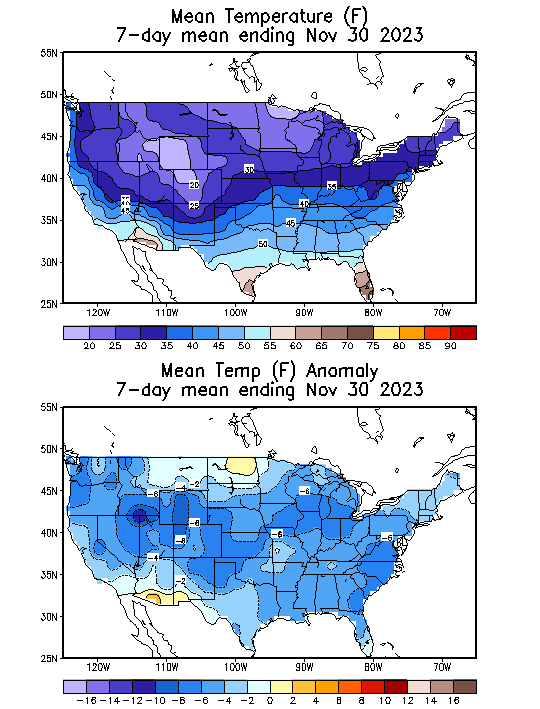
Data source: National Oceanic and Atmospheric Administration
Deviation between average and normal temperature (°F)
7-day mean ending Nov 30, 2023

Data source: National Oceanic and Atmospheric Administration

